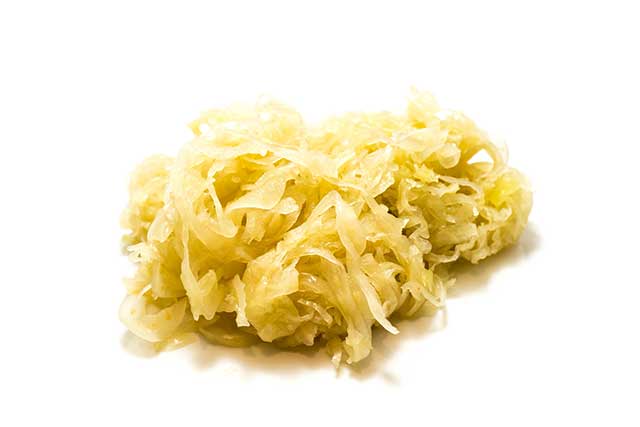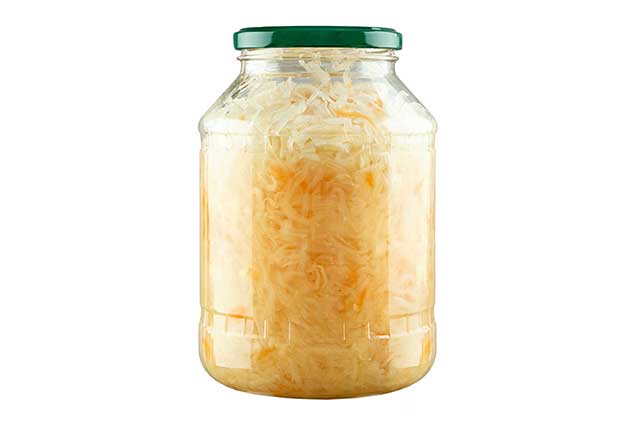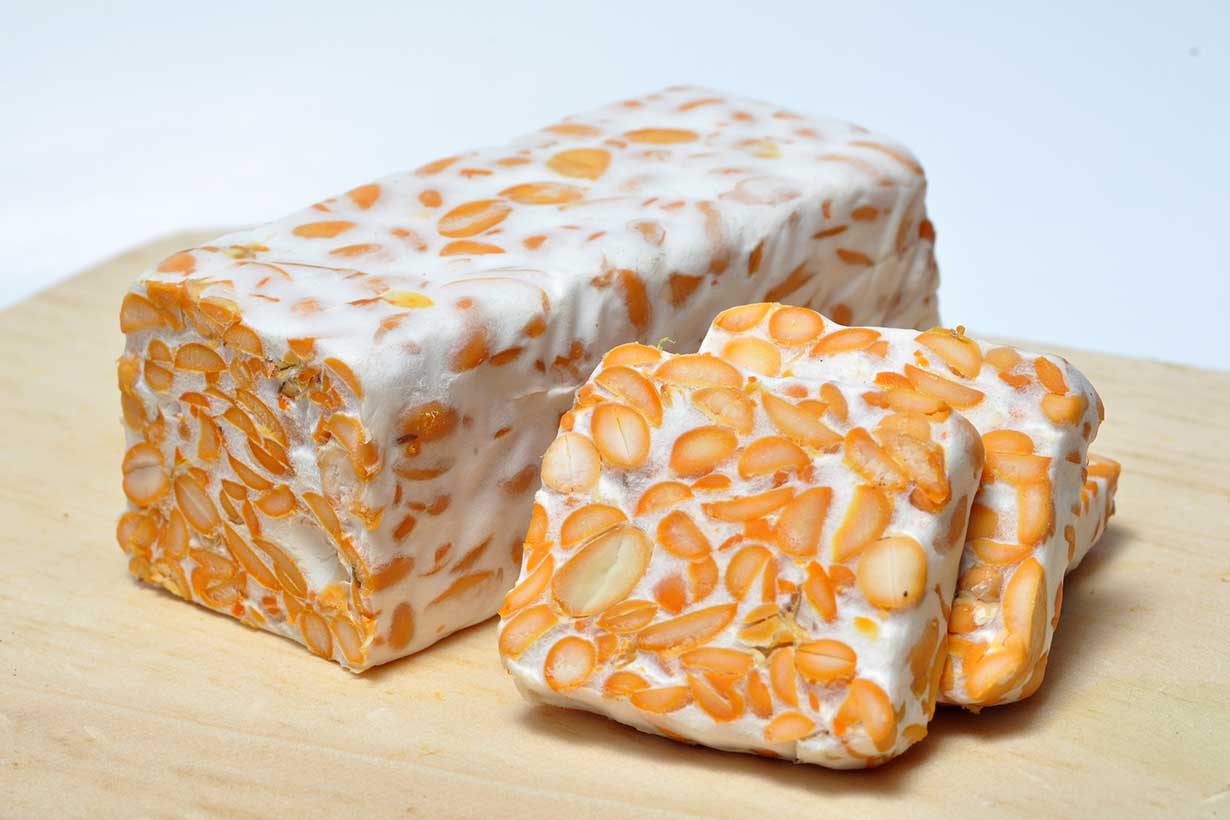Sauerkraut is a fermented vegetable dish widely used as a condiment and made through the lacto-fermentation of cabbage.
Similar to other fermented foods, there are many claims of health benefits surrounding sauerkraut.
However, which of these have scientific backing behind them?
This article provides a guide to the nutrition benefits of sauerkraut.

What Is Sauerkraut?
Sauerkraut is a popular side-dish and condiment, and it is especially famous in Germany.
In fact, sauerkraut is a German word which translates as “sour cabbage.”
Despite common belief, the origins of sauerkraut lie outside of Europe, and it appears to have originated in China.
Due to the lactic acid fermentation process it undergoes, sauerkraut is a source of various strains of lactic acid bacteria.
The dish has a slightly sweet, sour and vinegary flavor and a refreshing taste.
How Is It Made?
The production and fermentation process of sauerkraut is relatively straightforward.
First of all, producers shred cabbage into finely cut slices and then cover the cabbage in salt.
Following this, the sauerkraut is left to ferment until it reaches the desired state of maturity.
This natural fermentation requires only cabbage and salt, and it follows a similar production process to other fermented foods like kimchi.
However, in some instances, a probiotic starter culture, such as Lactobacillus plantarum, can be added to the mixture to accelerate the fermentation time (1).
Nutrition Facts
Aside from the extra salt (as sodium) content, sauerkraut has a very similar nutrition profile to regular cabbage.
The following tables show the full nutritional values per 100 grams (2).
| Calories/Nutrient | Amount | % DV |
|---|---|---|
| Calories | 19 kcal | – |
| Carbohydrate | 4.7 g | – |
| Fiber | 2.9 g | – |
| Sugars | 1.8 g | – |
| Fat | 0.1 g | – |
| Saturated Fat | 0.0 g | – |
| Monounsaturated Fat | 0.0 g | – |
| Polyunsaturated Fat | 0.1 g | – |
| Omega-3 Fatty Acids | 33.0 mg | – |
| Omega-6 Fatty Acids | 34.0 mg | – |
| Protein | 0.9 g | – |
| Vitamins | ||
| Vitamin C | 14.7 mg | 24 % |
| Vitamin K | 13.0 mcg | 16 % |
| Pyridoxine (B6) | 0.1 mcg | 6 % |
| Folate | 24.0 mcg | 6 % |
| Choline | 10.4 mg | 1.9 % |
| Pantothenic Acid (B5) | 0.1 mg | 1 % |
| Niacin (B3) | 0.1 mg | 1 % |
| Vitamin E | 0.1 mg | 1 % |
| Thiamin (B1) | Trace | 1 % |
| Riboflavin (B2) | Trace | 1 % |
| Vitamin A | Trace | Trace |
| Minerals | ||
| Sodium | 661 mg | 28 % |
| Iron | 1.5 mg | 8 % |
| Manganese | 0.2 mg | 8 % |
| Potassium | 170 mg | 5 % |
| Copper | 0.1 mg | 5 % |
| Magnesium | 13.0 mg | 3 % |
| Calcium | 30.0 mg | 3 % |
| Phosphorus | 20.0 mg | 2 % |
| Selenium | 0.6 mcg | 1 % |
| Zinc | 0.2 mg | 1 % |
Benefits of Sauerkraut
Here is a summary of the health benefits (and potential benefits) that sauerkraut can offer.
1) A Good Source of Vitamin C
Per 100 gram serving, sauerkraut offers approximately 14.7 mg of vitamin C, which is equal to 24% of the recommended intake.
Vitamin C is an important vitamin that has antioxidant properties, and research suggests it has a protective effect against oxidative stress in the body (3, 4).
In addition to this, vitamin C also plays an important role in the synthesis of collagen and improves the effectiveness of vitamin E (5).
2) Provides Probiotic Bacteria Such As Lactobacillus
Since sauerkraut undergoes a lactic acid fermentation process, it provides a range of probiotic bacteria strains.
According to tests undertaken on commercial sauerkraut samples, there is a wide range of bacterial species present. These “beneficial bacteria” strains include (6);
- Lactobacillus brevis
- Lactobacillus curvatus
- Lactobacillus plantarum
- Lactobacillus sakei
- Lactococcus lactis
- Leuconostoc citreum
- Leuconostoc fallax
- Leuconostoc mesenteroide
Research into the gut microbiome is ongoing. However, researchers believe probiotic bacteria may have benefits for gut health, and this could potentially help to influence overall immune health (7, 8, 9).
Canned Sauerkraut Is Different From Fresh Sauerkraut
However, it is worth bearing in mind that these bacteria strains are only present in fresh sauerkraut.
Fresh sauerkraut is perishable, and it will usually be refrigerated at the point of sale.
On the other hand, most canned/jarred sauerkraut products will have been pasteurized.
Unfortunately, this pasteurization process also kills the beneficial bacteria, so it will not be present in such products. Heating (via cooking) can also destroy these probiotic bacteria (10).
3) May Improve Symptoms of IBS
Irritable bowel syndrome (IBS) is a gastrointestinal condition that can lead to a broad range of symptoms.
Although the exact cause of IBS is not fully understood, it affects anywhere from 7% to 21% of the world’s population (11).
Symptoms of this condition may include abdominal pain, bloating, constipation, and diarrhea, among others (12).
On the positive side, some recent research suggests that sauerkraut may potentially help to manage symptoms of this chronic condition. For example, a recent randomized controlled intervention trial gave two groups of participants with IBS either fresh probiotic sauerkraut or inactive pasteurized sauerkraut (13).
Each group supplemented their daily diet with this sauerkraut for six weeks. At the end of the study period, both groups experienced “significantly improved” gut microbiota changes. Furthermore, the self-reported symptoms of IBS declined in severity.
Since both groups experienced benefits, the researchers stated that the results “can be attributed to the potential prebiotics (fiber) in lacto-fermented sauerkraut” rather than the probiotics.
However, this was only a small study, and more research is necessary.
4) High In Fiber

As shown in the nutrition profile, sauerkraut offers approximately 4.7 grams of carbohydrate per 100 grams.
Of this carbohydrate content, 2.9 grams comes from fiber (2).
Fiber has several potential benefits, and it can help to reduce the postprandial glycemic response (post-meal rise in blood sugar) to carbohydrate (14).
Additionally, microbes in the gastrointestinal tract can metabolize fiber into beneficial compounds like butyrate (15).
Dietary fiber also seems to have a beneficial impact on the overall health of the gut microbiota (16).
5) Contains Isothiocyanates and Ascorbigen
Sauerkraut is a source of two chemical compounds called isothiocyanate and ascorbigen.
All cruciferous vegetables contain isothiocyanates, and ascorbigen develops during the fermentation of white cabbage (17).
Both of these compounds are thought to have cancer-protective properties (18, 19, 20).
That said, we should note that these findings are mainly from observational studies. In other words; correlation does not infer causation.
This means that although an association exists, the studies cannot prove that isothiocyanate and ascorbigen have this effect within the human body.
Some mouse studies do show that isothiocyanate extracts can offer cancer-protective effects (21).
However, higher-quality human studies are necessary to confirm these claimed benefits.
6) Contains (Small Amounts) of Vitamin K2
Another important vitamin that sauerkraut provides is vitamin K2.
Vitamin K2 is thought to play an important role in skeletal health and may help to direct calcium toward bone and away from arteries (22, 23).
Not many foods contain vitamin K2, and we can primarily find it in fatty animal foods and fermented soy products.
Although sauerkraut does provide a source of this nutrient, it is only a small quantity.
For instance, research reviewing food sources of vitamin K2 shows that the Japanese fermented dish natto, hard cheese, and certain cuts of meat offer higher amounts (24).
Potential Drawbacks of Sauerkraut
In addition to the potential benefits of sauerkraut, adverse effects are possible in some situations.
1) Sauerkraut Is High In Salt
First of all, due to the fermentation/pickling process, sauerkraut is a significant source of salt.
Per 100 grams, sauerkraut contains 661 mg of sodium, which is equivalent to approximately 1.65 grams of salt (2).
Although the dangers of salt have been somewhat exaggerated in the media, high amounts of salt can be harmful to certain individuals.
For instance, high intakes of dietary salt can cause significant increases in blood pressure for people with hypertension or salt sensitivity (25, 26).
Observational and animal studies also suggest that high salt intake could be problematic in the presence of H.Pylori, which is a type of stomach infection (27).
How To Use Sauerkraut
There are many different ways to use sauerkraut, and people usually eat it as a side alongside meat-based foods.
For example, people enjoy using sauerkraut alongside BBQ food as well as unhealthier options like hot dogs. With these foods, sauerkraut is typically served raw.
However, there is also a wide range of cooked sauerkraut dishes that enjoy popularity.
For a large variety of ideas, you can find a big collection of sauerkraut recipes here.
Final Thoughts
All in all, sauerkraut is a tasty and refreshing side dish that offers several potential benefits.
Although it is a little high in salt, the benefits likely outweigh the drawbacks for the majority of people.
As a bonus, sauerkraut also makes an excellent food pairing and has an enjoyable taste.
For more tasty condiments, see this guide to salsa or this in-depth look at hummus.






I have been making sauerkraut for years for its probiotics. I add probiotic ferment and decrease the quantity of salt by 1/4. The added probiotics prevent bad microorganisms from growing, but allow the natural beneficial microorganisms to grow. In fact I observed that the probiotic properties of sauerkraut remain for about 3 weeks in the refrigerator.
Sounds like you know what you’re doing. I’ve tried making sauerkraut several times, and kimchi too… both are very good.
That is exactly what I do but my sauerkraut never lasts 3 weeks in the refrigerator. I eat it all way before then.
I add salt at 1% of cabbage weight, so the sauerkraut is not too salty
Sounds good!